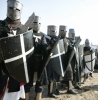|
 Armour
collecting is something too different from the trivial activity that is
affordable to very wealthy people or the amateur enthusiasts who put their
lives to study the history of armament the Middle Ages. During the old times the defensive weapons meant the armament.
We never neglect the fact that
in the current times anyone who wants to «collect» modern replicas styled as the
ancient rarity, though we admit that this is done exclusively by those who want
to make their interior look more elegant and pretentious demonstrating the
decorative armour on the special platform. Armour
collecting is something too different from the trivial activity that is
affordable to very wealthy people or the amateur enthusiasts who put their
lives to study the history of armament the Middle Ages. During the old times the defensive weapons meant the armament.
We never neglect the fact that
in the current times anyone who wants to «collect» modern replicas styled as the
ancient rarity, though we admit that this is done exclusively by those who want
to make their interior look more elegant and pretentious demonstrating the
decorative armour on the special platform.
When surfing
the shops and flee markets for the rarity stuff to decorate the interior, you'd
better consider that the armour would look applicable and unique in the
interior of a villa in the suburbs rather that in the old Scottish or German
castle where it looks weird and ridiculous.
Today more and
more prosperous people tend to pay a fortune to get some weapons for their
villas.
We should not
think of the armour solely off the history of the human society development.
The armour picked the technological progress on the particular stage of
history. The armours were designed to protect the life - the most vital for the
humans, and they have been sophisticated since the ancient times up to XVII century.
To manufacture the armours, the weapon makers incurred enormous expenses
including material and masters' work payment, and hence, the cuirasses were too
costly and affordable to the individual of high income. Moreover, the armours would
be decorated to demonstrate the status, merits and regalia of the owner, and
therefore the coat of arms and battles with fighting knights or the ancestors
were embossed on the armours.
Hence, the armours
may be thought as decorative and applied art works and here they seem unique to
appear in the collection of any medievalist. Historical evens are easy to carve
or emboss onto the armours thanks the scenes are easy to imagine, as well as the
life and morals of the society of that time.
The first armours
used by people were the roughly-processed pelts that had their defensive
function, though they protected from the cold rather than from the primitive
stone-made weapon. Further, as the metal production developed, people invented
other means to protect themselves. In the early Middle Ages one of the well-accepted
armours was the laminar ones; they were special in construction when metal
plates were tied one to another with straps. The specialists suppose that Old
Russian warriors used the shell within IХ-X centuries. The most successful kind of the «heavy»
protection is the laminar armours that gave relatively good mobility.
This kind of
armour has been made of several hundred of plates of random shape tied with one
another with laces by artful overlapping, and the most popular armour was
brigandine.
Brigandine
was made in the manner when metal plates were fixed onto the leather base from
inner part to allow the mobility, and the armour was lined from the outer side
with rich fabric.
In the late
Middle Ages single metal armour appeared which are more familiar to the wide
population and which are the nice bit for the collector with perfect features
to keep and due to esthetic look.
The ones
who are interested in the cost of such armours will be surprised to know that
in summer Sotheby's auctioned unusual and unique lots, in particular the English
sword of XIV century (with the start price of 3-4 thousand pounds sterling), the
Gothic styled Dutch armour dated back to the end of XV century (20-30 thousand
pounds sterling) and, the most interesting, the three-quarter armour from 1580 belonging
to the knight of the town watch in Munich. The auction facilitators estimated
the armours for 8 to 10 thousand pounds.
The Japanese
samurai armour had a great vogue with collectors no less than European items.
The Japanese armour is known for little metal but more luxury in weapon. The Japanese
armourers were assigned to make their armour easily recognizable in battles.
Thus, all protective parts, including neck, chest and rib elements, armlets and
shoulder straps were made raised with individual peculiarities, while helmets
were decorated with attires and whimsical curves of edges. The outcome was impressive
and majestic, and due to the well designed construction the armour never
hobbled during dismounted either mounted action.
Recently it
is believed to be good manners to keep the collection of original samurai
armour in the Japanese villas.
|